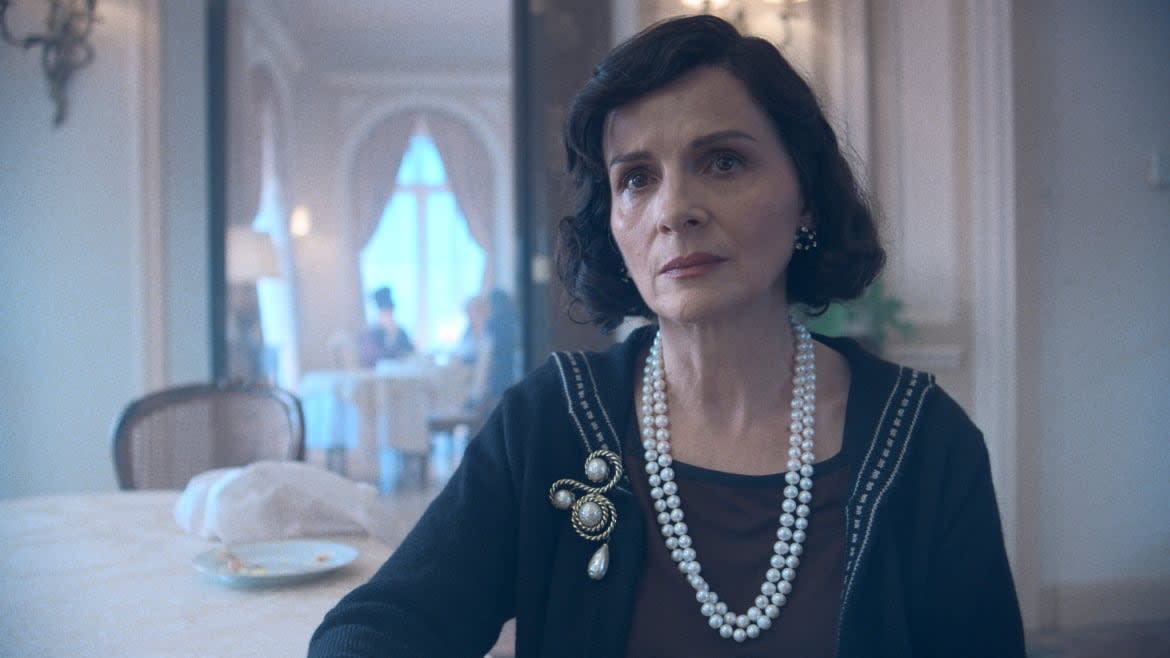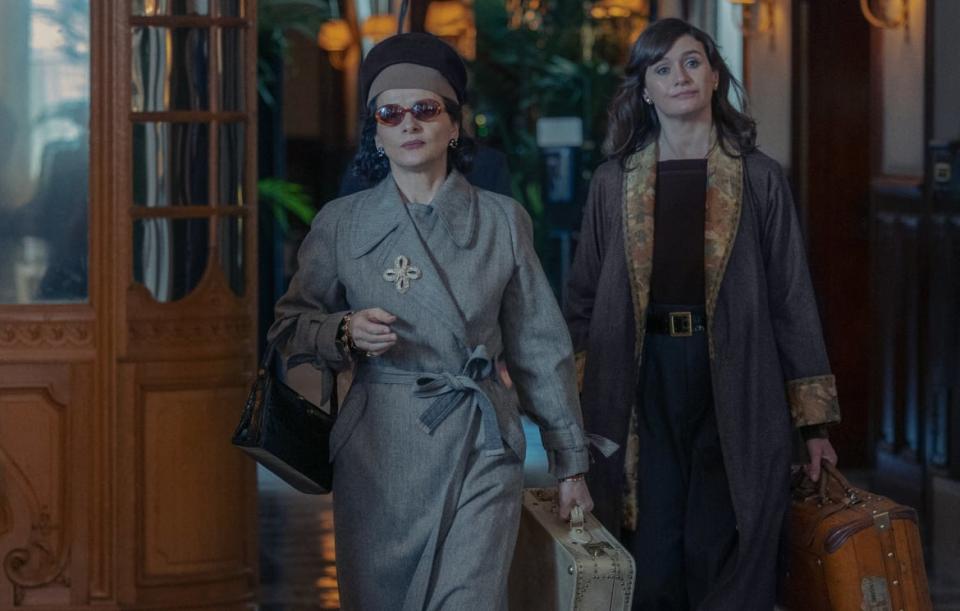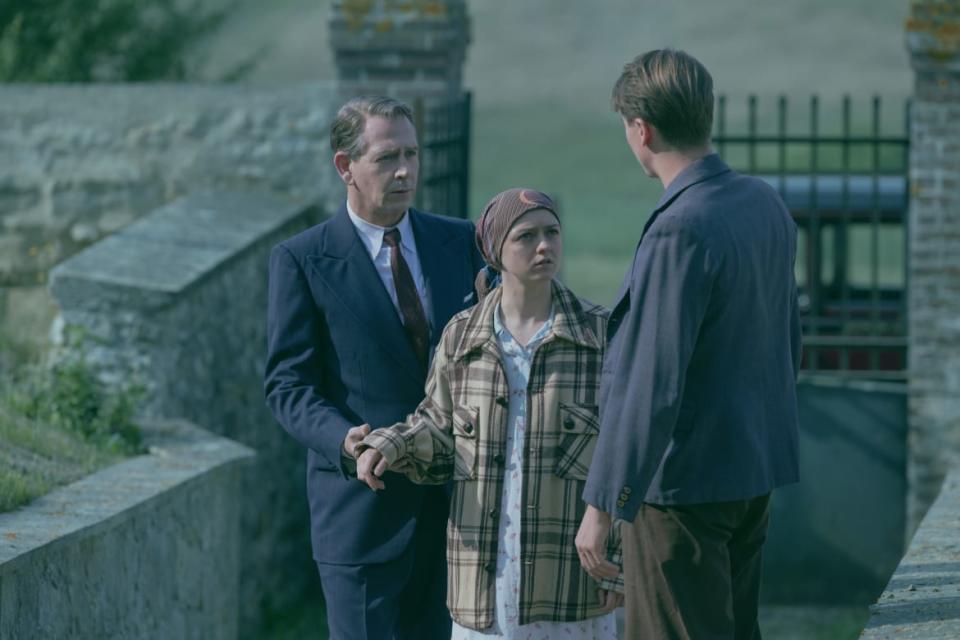‘The New Look’: How Juliette Binoche Tackled the Stormy Life of Coco Chanel

- Oops!Something went wrong.Please try again later.
(Warning: Spoilers for The New Look ahead.)
It’s hard to imagine a world where Coco Chanel’s (Juliette Binoche) name is not on a guest list. However, rejection did happen—and is swift—in a recent episode of Apple TV+ historical drama The New Look, when Coco tries to enter a lavish party at the luxury Swiss hotel she currently calls home.
At the end of WWII, friends and money were in short supply for the designer, who self-exiled from Paris after French authorities started to investigate her ties to the Nazis. Without her Parisian boutique, Coco lacked financial stability and threatened legal action against her former partners, the Wertheimers. So you’d think Coco would welcome a visitor from the past with open arms. But this critical juncture in her life, Coco needed to keep certain skeletons in her closet, and discretion certainly was not in fashion whenever socialite Elsa Lombardi (Emily Mortimer) stepped—or staggered—into a room, as she does in Episode 6 of the series.
Complicating matters further is the fact that the last time Coco saw her best frenemy, Elsa, was during the Occupation when they hopped on a train to Spain as part of a top-secret mission to contact Winston Churchill on behalf of a rogue faction of Nazi officers going against Adolf Hitler. “When she [Coco] was asked to go to Madrid and somehow stop the war: Can you imagine this woman stopping the war? I’m not sure if she wanted to do it, but she tried,” Juliette Binoche tells The Daily Beast’s Obsessed.
It is a turn of events that reads like something out of a spy novel, sending two glamorous women no one will suspect to pass on a message to one of the key Allied leaders in a bid to end the war. Operation Modellhut (‘model hat’) failed, and Elsa later sold Coco out to the British Embassy regarding her collaboration with the Nazis. So this post-war reunion in Switzerland bubbled with tension. So many of these scenes in the series seem fantastical, but they are based on truth—or at least an assumed truth when it comes to Churchill saving her skin.
Chanel’s friends and acquaintances are as contradictory as her actions: feminist trailblazer and fashion mogul who paired pearls with pants; self-serving and shrewd; incredibly generous and charitable; romantically involved with Nazis and the French Resistance; an impoverished childhood and schmoozing with aristocrats; fell in love again and again but never married; inspired and designed for icons like Picasso; and died a legend at the age of 87.
Binoche best sums it up when I mention that we have barely scratched the surface in our conversation about Chanel’s contradictions: “You can’t stop because there’s so much, there’s so much.”
The New Look captures the often antithetical actions of Coco Chanel, a woman who has close ties to Gestapo officer Hans Günther “Spatz” von Dincklage (Claes Bang) and French Resistance fighter Pierre Reverdy (Sagamore Stévinin)—not to mention the British Prime Minister.
“She was not impressed or intimidated by wealth or Winston Churchill because she wanted so much from life. Coming from the poorest family, there was this freedom, but the need was huge,” says Binoche. “So I think it really made me understand [her choices] during the Second World War; why would she hold onto things without retaining any kind of moral ideas about what was right or wrong.”
The ‘Queens’ Giving a Middle Finger to Sexism—and Changing Wildlife TV
Creator Todd A. Kessler depicts Coco’s wartime journey running parallel in The New Look with upcoming designer Christian Dior (Ben Mendelsohn), both of whom struggle with how the Nazi Occupation breaks apart their family. Whereas Coco made a deal with Spatz to ensure her nephew André (Joseph Olivennes) is freed from a POW camp, Christian has to sit and wait to find out whether his sister Catherine (Maisie Williams)—who was part of the French Resistance—survived her ordeal in the Ravensbrück concentration camp. When Catherine does come home, she is understandably traumatized by her experience.
Sympathy for the designer is hard to come by when her financial woes are juxtaposed with everything the Diors are going through. Still, Elsa provides invaluable insight into Coco’s motivations—even if she is inebriated the entire time. Understanding Chanel means turning the clock back to before the war, and rather than the series relying on flashbacks, bringing Elsa back into her orbit gives an ongoing glimpse of Coco’s survival story. Mortimer and Binoche deftly portray the highs and lows of a friendship that endured backstabbing and mean retorts while showing how small their social circle has become—thanks, in part, to their trip to Madrid.

Juliette Binoche and Emily Mortimer
Kessler specializes in dramatizing complex fictional characters on shows like Damages and Bloodline but, with these characters in The New Look, has a wealth of real background material to utilize. “What was very important to us telling the story is to help dimensionalize Coco Chanel,” Kessler says. “She is someone who has friends, who's competitive, who has a whole life outside of just the context of what we're seeing her in in the moment of Occupied Paris.”
Binoche, Kessler, and executive producer Lorenzo di Bonaventura talked to Obsessed about finding Coco Chanel in all her guises, Elsa’s layered revelatory role, and the two women Elsa is based on.
Finding Coco Chanel
In researching Chanel, Binoche discovered the array of conflicting stories about the fashion legend was as informative as it was baffling: “Well, compared to what I know today, at the time, I didn’t know anything. And it takes time to know her because when you read one book, you read another, and then there’s other information you’re getting—all contradictory information. It takes a while to understand who she is because it feels like she's avoiding the truth somehow.”
When we meet Coco in 1941 in The New Look, she has experienced tragedy and great success. Read any biography of Coco Chanel, and you probably do a double-take at the journey she took to become one of the most recognized names in fashion. During our conversation, Binoche mentions figures who appear in the series, like Resistance fighter Reverdy, as well as others Chanel knew before the war. This list reads like a who’s who, giving the impression that Chanel lived a Forrest Gump-like existence, her dating pool crisscrossing with important figures such as White Russian aristocrat Grand Duke Dmitri Pavlovich—who was part of the plot to kill Rasputin—and the Duke of Westminster.
When Chanel opened her business, a woman couldn’t have a bank account and had to turn to men to make her dream a reality. “When you first read about this period with her, it’s easy to cast her in a negative light. But the truth is, if you look in the past, she’s an amazing person,” says di Bonaventura. “The success of what she did as a woman during that time period is staggering.”
The Wild Stories Behind ‘Love Lies Bleeding,’ a ‘Barbaric’ Lesbian Romance
Binoche describes Chanel’s “very traumatized childhood, with a mother dying when she was 11 [and] her father abandon[ing] the family” as a driving force. The future global face of fashion was separated from her siblings, growing up in an orphanage and later taking responsibility for her nephew André when her sister died by suicide. “This scattered family made her want to hold onto things, make things, have a fun life, and open herself up to everything—any occasion. I would say with arts but also with lovers, with possibilities,” says Binoche.
Enter Elsa Lombardi, who is based on two different women. “Elsa in the TV show is Vera Bate [Lomabardi], who was an English from an aristocratic branch, and Misia Sert, who was originally Polish, was an excellent pianist, had three different husbands, was an amazing artist, and would educate Chanel and bring her into the world she was living in,” says Binoche.
Sert was a muse for Pierre-Auguste Renoir, and in this pre-WWII era, Sert and Chanel hung out with the likes of Pablo Picasso and Igor Stravinsky. Rather than portray two different characters to represent this aspect of Chanel’s life, the show combines the two (Bate Lombardi did accompany Chanel to Madrid). “The relationship that we tell in the show with Elsa [is that] there was so much fun but a lot of competition as well,” says Binoche.
The Elsa Lombardi conundrum
While Coco faced no charges for collaborating with Spatz, liberated Paris and her beloved Ritz Hotel are no longer safe havens for her, but neither is Switzerland now that Elsa has reappeared. Her lack of financial security is an overarching theme in Episode 6, “If You Believed In Me,” showcasing Coco’s rage at the Wertheimer brothers who own her company. If you begin to feel sympathy for the designer, the anti-Semitic rhetoric and the reminder that she tried to use the Nazi Aryan laws to forcibly take her business from her Jewish partners are a stark reminder of Coco’s inability to look inward at the ugliness she spouts.
Coco first got into bed (literally) with the Nazis around the time she was trying to free her nephew from a POW camp. “Her life is one series of survival decisions after another, and so it’s quite easy in retrospect to look back and go, ‘Those are not some great choices,’” says di Bonaventura. “But the truth of the matter is, I think she is the kind of person who didn’t really think even almost a week ahead. She was thinking about that day: What is it I’m going to do to survive to the maximum?”
Similarly, Elsa is stained by the Madrid incident, and leaving Coco high and dry at the British Embassy doesn’t stop Elsa’s family in England from branding Elsa a traitor. Elsa is desperate for money, resorting to thinly-veiled blackmail: “If you want me to keep quiet about what I know, why don’t you make sure I get what you promised me?”

Ben Mendelsohn and Maisie Williams
This isn’t the only point of contention, as Elsa is still smarting from a public disagreement in the second episode. A frustrated Elsa first pulls at every personal thread in pointing out Coco is sleeping with a Nazi and reminding her that Coco’s father abandoned her, before accusing Coco of stealing her style and talent.
Coco quickly fires back at Elsa. “Chanel lambasts her and says that she [Chanel] can make more with a tablecloth than she could out of [Elsa’s] entire heart and soul,” says Kessler. “The idea of life is turning yourself into something bigger than yourself, that’s what success is.” Elsa makes sure to mention in Switzerland how hurt she was by this personal attack.
But Elsa is also quick to forgive Coco because, like Chanel, she doesn’t have many options, and their friendship dates back decades. In quiet moments between the pair, Kessler reveals Coco beyond her current turbulent situation. “When they're sitting on the train [in Episode 2], and she [Elsa] says, ‘Sing the song to me that you used to sing.’ Chanel wanted to be a singer. She wanted to be an actor. She was in the south of France and trying to perform,” Kessler says. “It’s just not a way that we would see her during Occupied Paris unless we could bring in a friend like that to portray that.”
However, with everything that has transpired, Binoche points out that Coco’s “relationships started to be very complicated and dark.” Long gone are the days of hanging out with Picasso, Renoir, and Stravinsky, and whether this friendship can endure like the Chanel brand has is yet to be seen.
“She’s a fascinating woman, and I think this strength that came from this damaged, poor little girl, I think towards the end, made her a prisoner,” says Binoche. “Because she became more and more alone in her empire.”
Get the Daily Beast's biggest scoops and scandals delivered right to your inbox. Sign up now.
Stay informed and gain unlimited access to the Daily Beast's unmatched reporting. Subscribe now.

